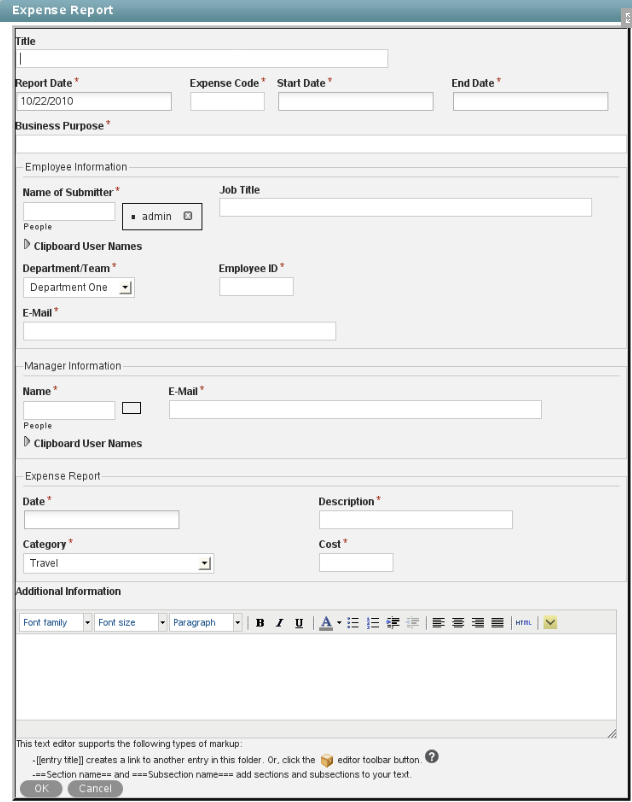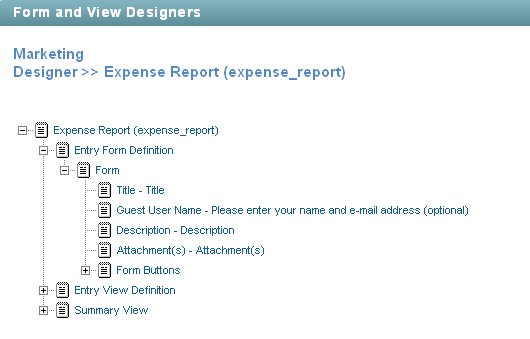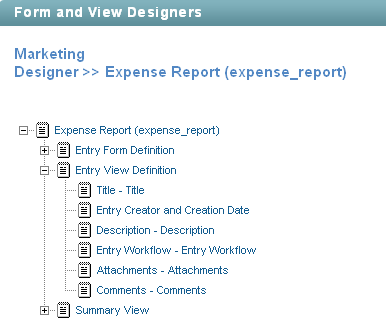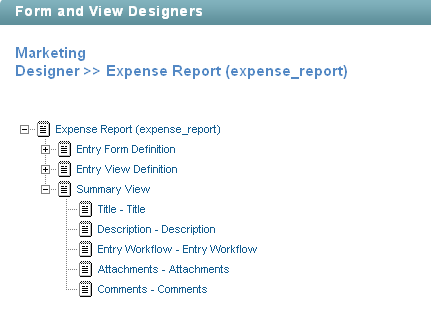9.3 Creating a Custom Folder Entry Form
Novell Vibe enables you to create custom folder entry forms that contain fields that are unique to your needs. To do this, you must create both the form and the view. For more information about forms and views, see Section 9.2, Understanding Entry Forms and Views.
For example, you can create a custom entry form for an expense report.

9.3.1 Creating the Folder Entry Form
-
Navigate to the folder or workspace where you want to create the custom entry form.
If you create the entry form in a folder, the form can be applied only to entries in that folder. If you create the entry form in a workspace, the form can be applied to entries in any folder in the workspace.
-
If you are creating the entry form at the folder level, click > in the Action toolbar.
or
If you are creating the entry form at the workspace level, click > in the Action toolbar.
The Form and View Designers page is displayed.
-
Click > .
The Add a New Definition form is displayed.
-
Specify the following information in the Add a New Definition section:
Caption: Specify a name for the folder entry.
This is the name that appears in the Vibe interface. Users see it when they create an entry of this type. (For example, “Expense Report.”)
Name: Specify the internal name for the folder entry.
The name that you enter in this field is not visible to users who create this type of entry. (For example, “expense_report.”)
Family: Select the item type that is closest to the function of the item you are creating. Users can use the family type when performing filtered searches.
Allowed Comments/Reply Types: Select all of the comments or reply types that you want to allow on the entry.
When users comment on this type of entry, they can choose from the options that you specify in this section.
To select multiple options, hold the Ctrl key while selecting the comment or reply types.
-
Click .
-
Continue with Section 9.3.2, Adding Elements to the Entry Form Definition.
9.3.2 Adding Elements to the Entry Form Definition
The entry form is what users see when they are creating a new entry. This form needs to contain all of the fields necessary for users to create this type of entry. For example, an Expense Report form needs to contain the expense code, the purpose for the expense, the cost of the expense, and so forth.
After you add elements and layout options to the entry form, you must then add all of the elements and layout options to the entry view in order for them to be displayed when users view the entry. (For information on how to add elements to the entry view, see Section 9.3.3, Adding Elements to the Entry View Definition.)
To add elements to the form:
-
Under the custom entry form that you created, expand , then expand .
All of the elements and layout options that are currently applied to your form are displayed.

-
Add, modify, and delete the desired elements and layout options, as described in the following sections:
Based on the modifications that you make to a form element or option, you might need to make the same modifications to the corresponding view element or option.
Adding Elements to a Form
-
Click .
-
In the Form window on the right side of the page, click .
-
In the section, click the element that you want to add.
For information on the types of elements that you can add, see Section 9.5.1, Entry Form Elements.
-
Specify the appropriate information to configure the element.
-
Click .
Modifying Elements in a Form
-
Expand , then click the element that you want to modify.
-
In the window on the right side of the page, click .
-
Make the desired modifications, such as changing the caption or data name, then click .
Deleting Elements in a Form
-
Expand , then click the element that you want to delete.
-
In the window on the right side of the page, click .
-
Click .
Adding Layout Options to a Form
-
Click .
-
In the Form window on the right side of the page, click .
-
In the section, click the layout option that you want to add.
For information on the types of layout options that you can add, see Section 9.6, Understanding Layout Options.
-
Specify the appropriate information to configure the element.
-
Click .
9.3.3 Adding Elements to the Entry View Definition
The entry view is how the information from your entry form is displayed to users who view your entry. Every form must have a corresponding view. This view needs to contain all of the fields necessary for users to get the information they need when viewing the entry; it is made up of elements from the form.
Before you can add elements and layout options to the entry view, you must first add those same elements and layout options to the entry form in order for them to be displayed in your entry. (For information on how to add features to the entry form, see Section 9.3.2, Adding Elements to the Entry Form Definition.)
To add elements to the view:
-
Under the custom entry form that you created, expand .

-
Add, modify, and delete the desired elements and layout options, as described in the following sections:
Adding Elements to an Entry View Definition
-
Click .
-
In the Entry View Definition window on the right side of the page, click .
-
In the section, click the element that you want to add.
For information on the types of elements that you can add, see Section 9.5.2, Entry View Elements.
-
Specify the appropriate information to configure the element.
-
Click .
Modifying Elements in an Entry View Definition
-
Expand , then click the element that you want to modify.
-
In the window on the right side of the page, click .
-
Make the desired modifications, then click .
Deleting Elements in an Entry View Definition
-
Expand , then click the element that you want to delete.
-
In the window on the right side of the page, click .
-
Click .
Adding Layout Options to an Entry View Definition
-
Click .
-
In the Entry View Definition window on the right side of the page, click .
-
In the section, click the layout option that you want to add.
For information on the types of layout options that you can add, see Section 9.6, Understanding Layout Options.
-
Specify the appropriate information to configure the element.
-
Click .
9.3.4 Adding Elements to the Summary View
The summary view is used to display entries in a folder before the entries are opened.
To add elements to the summary view:
-
Under the custom entry form that you created, expand .

-
Add, modify, and delete the desired elements and layout options, as described in the following sections:
Adding Elements to a Summary View
-
Click .
-
In the Summary View window on the right side of the page, click .
-
In the section, click the element that you want to add.
For information on the types of elements that you can add, see Section 9.5.2, Entry View Elements.
-
Specify the appropriate information to configure the element.
-
Click .
Modifying Elements in an Summary View Definition
-
Expand , then click the element that you want to modify.
-
In the window on the right side of the page, click .
-
Make the desired modifications, then click .
Deleting Elements in an Summary View Definition
-
Expand , then click the element that you want to delete.
-
In the window on the right side of the page, click .
-
Click .
Adding Layout Options to a Summary View
-
Click .
-
In the Summary View window on the right side of the page, click .
-
In the section, click the layout option that you want to add.
For information on the types of layout options that you can add, see Section 9.6, Understanding Layout Options.
-
Specify the appropriate information to configure the element.
-
Click .